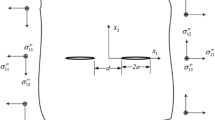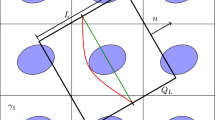Abstract
The modified mapping collocation method is extended for the solution of plane problems of anisotropic elasticity in the presence of multiple defects in the form of holes, cracks, and inclusions under general loading conditions. The approach is applied to examine the stress and strain fields in an anisotropic finite region including an elliptical and a circular hole, an elliptical flexible inclusion, and a line crack. It can be readily incorporated into micro-mechanics models, capturing the relative importance of the matrix, the fiber/matrix interface, and reinforcement geometry and arrangement while estimating the effective elastic properties of composite materials. The accuracy and robustness of this method is established through comparison with results obtained from finite element analysis.
Similar content being viewed by others
References
Bowie, O.L. (1956). Analysis of an infinite plate containing radial cracks originating at the boundary of an internal circular hole. Journal of Mathematics and Physics 35, 60–71.
Bowie, O.L. and Neal, D.M. (1970). A modified mapping–collocation technique for accurate calculation of stress intensity factors. International Journal of Fracture Mechanics 6, 199–206.
Chen, W.H. and Chang, C.S. (1990). Analysis of multiple cracks in an infinite plate under arbitrary crack surface tractions. Ingenieur–Archiv. 60, 202–212.
Gifford, L.N. and Hilton, P.D. (1981). Preliminary documentation of PAPST – Non–linear fracture and stress analysis by finite elements. NSRDC – Preliminary Documentation, Naval Ship Research Development Center, Bethesda, Maryland.
Haddon, R.A. (1967). Stresses in an infinite plate with two unequal circular holes. Quarterly Journal of Mechanics and Applied Mathematics 20, 277–291.
Horii, H. and Nemat–Nasser, S. (1985). Elastic fields of interacting inhomogeneities. International Journal of Solids and Structures 21, 731–745.
Lee, J. and Mal, A. (1997). A volume integral equation technique for multiple inclusion and crack interaction problems. ASME Journal of Applied Mechanics 64, 23–31.
Lekhnitskii, S.G. (1968). Anisotropic Plates. Gordon and Breach Science Publishers, Inc., New York.
Meguid, S.A. and Shen, C.L. (1992). On the elastic fields of interacting defense and main hole systems. International Journal of Mechanical Sciences 34, 17–29.
Sih, G.C., Paris, P.C. and Irwin, G.R. (1965). On cracks in rectilinearly anisotropic bodies. International Journal of Fracture Mechanics 1, 189–203.
Sloan, S.W. (1989). Fortran program for profile and wavefront reduction. International Journal for Numerical Methods in Engineering 28, 2651–2679.
Author information
Authors and Affiliations
Rights and permissions
About this article
Cite this article
Madenci, E., Sergeev, B. & Shkarayev, S. Boundary collocation method for multiple defect interactions in an anisotropic finite region. International Journal of Fracture 94, 339–355 (1998). https://doi.org/10.1023/A:1007555101061
Issue Date:
DOI: https://doi.org/10.1023/A:1007555101061




